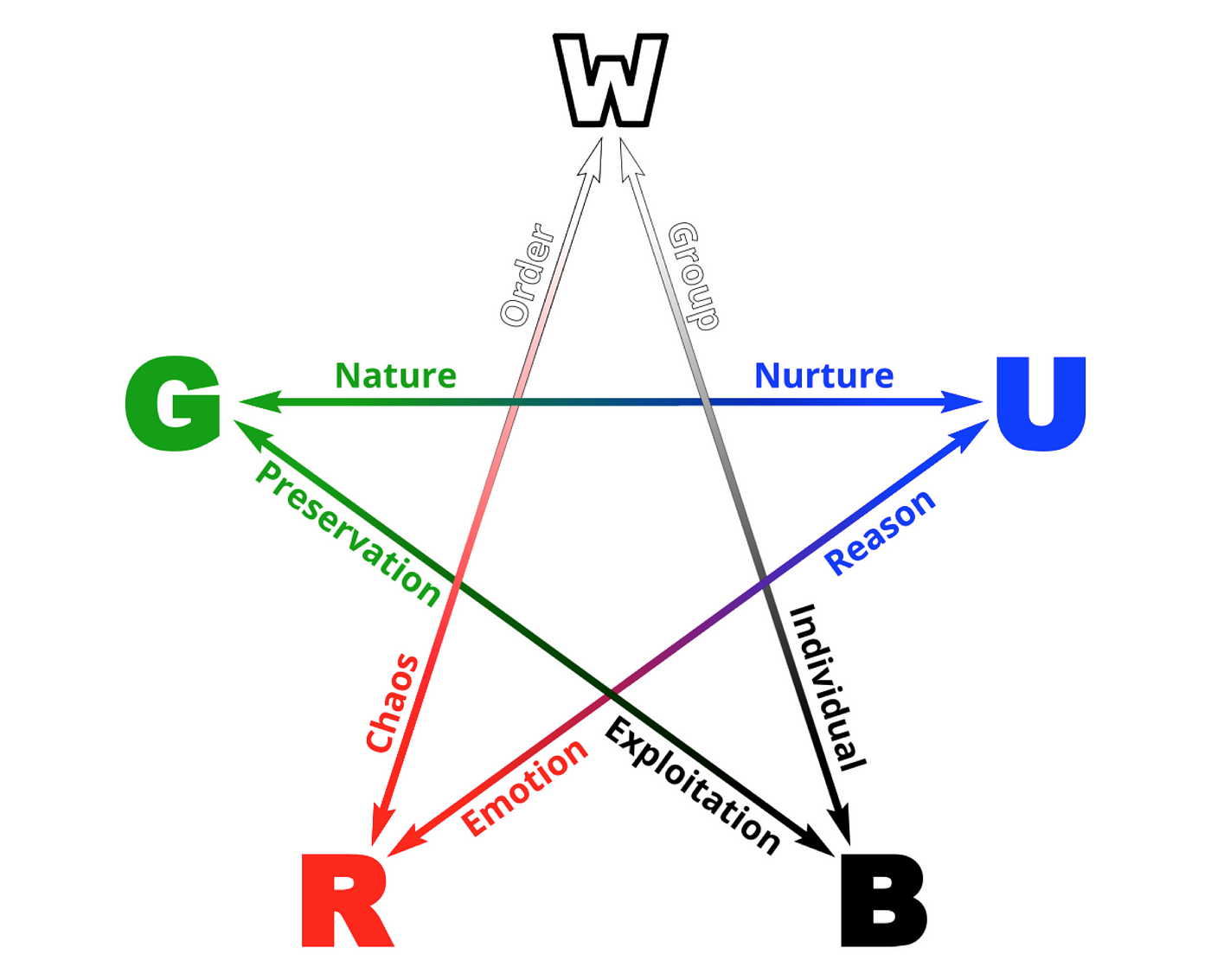Bupp
Adventurer
I'm looking into using the five colors as an alignment chart, as opposed to nine axis alignment, the good/neutral/chaos trinity or 4e's five alignment sliding scale.
It's an idea I've tinkered with in my head, but never had a chance to implement.
Plane Shift: Ixalan was the thing that really got me thinking about this. If you don't want to dig thru the whole Ixalan pdf, I pulled out the pertinent part on my blog.
Many discussions try to shoehorn some white=good while black=evil stereotypes into the color wheel. The color wheel does not work that way. Each color, when taken to an extreme, is capable of evil. Planeshift Ixalan does hint at this a bit.
For those of you that want to really dig into it, Mark Rosewater (Maro), Lead Designer of Magic wrote about each of the colors in the color pie. He wrote about them each having a belief system. He did this so that from a design standpoint, but in doing so really explores what each color believes, and isn't that what alignment really is? Boils down to what does the color want, and how does it get it?
He asks six questions to really delve into it.
White
Blue
Black
Red
Green
In Pie Fights, Maro delves into the conflicts between the colors, and in Thank You For Being a Friend, he explores the allied color pairings. Edited to add... Hate is Enough, discussing why the colors hate each other.
Finally, while searching for those articles, I came across "How the Color Wheel Explains Humanity" by Duncan A. Sabian. The first half he more or less rephrases each of Maro's articles above, but also delves more into what the two and three color pairings believe. It's also home to some helpful diagrams that explain these conflicts and alliances between the color pairings, such as this one illustrating the conflicts between individual colors:

Mr. Sabian explains the good/evil dichotomy not fitting any of the colors well.
It's an idea I've tinkered with in my head, but never had a chance to implement.
Plane Shift: Ixalan was the thing that really got me thinking about this. If you don't want to dig thru the whole Ixalan pdf, I pulled out the pertinent part on my blog.
Many discussions try to shoehorn some white=good while black=evil stereotypes into the color wheel. The color wheel does not work that way. Each color, when taken to an extreme, is capable of evil. Planeshift Ixalan does hint at this a bit.
For those of you that want to really dig into it, Mark Rosewater (Maro), Lead Designer of Magic wrote about each of the colors in the color pie. He wrote about them each having a belief system. He did this so that from a design standpoint, but in doing so really explores what each color believes, and isn't that what alignment really is? Boils down to what does the color want, and how does it get it?
He asks six questions to really delve into it.
- What does the color desire? What is its end goal?
- What means does the color use to achieve these ends?
- What does the color care about? What does the color represent?
- What does the color despise? What negatively drives the color?
- Why does the color like its allies and hate its enemies?
- What is the color's greatest strength and biggest weakness?
White
Blue
Black
Red
Green
In Pie Fights, Maro delves into the conflicts between the colors, and in Thank You For Being a Friend, he explores the allied color pairings. Edited to add... Hate is Enough, discussing why the colors hate each other.
Finally, while searching for those articles, I came across "How the Color Wheel Explains Humanity" by Duncan A. Sabian. The first half he more or less rephrases each of Maro's articles above, but also delves more into what the two and three color pairings believe. It's also home to some helpful diagrams that explain these conflicts and alliances between the color pairings, such as this one illustrating the conflicts between individual colors:

Mr. Sabian explains the good/evil dichotomy not fitting any of the colors well.
It’s worth noting that the colors speak largely to goals and means. Traits like “good” or “evil” do not map to the color wheel, since every color has ways in which it can be either. Similarly, emotions like love and hate can crop up in every color, as can characteristics like compassion or gregariousness or elegance — the difference is in how people respond to those emotions and those characteristics. All of the colors can feel strong emotion, but red responds to them by following them, while blue responds to them by investigating them. All of the colors can be polite, but white does so out of pro-sociality, whereas black does so transactionally.
Last edited:

